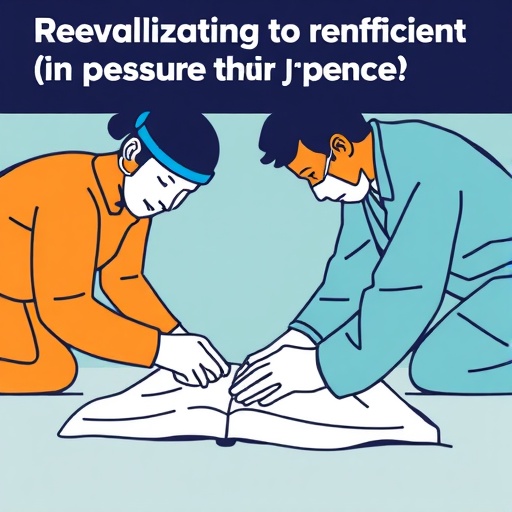In the realm of modern healthcare, the management of pressure injuries—primarily in patients with limited mobility—has garnered significant attention from researchers and clinicians alike. A recent study published in BMC Health Services Research introduces a scoping review, delving into the low-value clinical practices that often permeate pressure injury management. This comprehensive examination, led by Jiang and colleagues, illuminates the importance of optimizing patient care and resource allocation in the face of evolving healthcare demands.
Pressure injuries, also known as pressure ulcers or bedsores, represent a critical concern within the healthcare landscape. They arise from prolonged pressure on the skin and underlying tissues, frequently affecting individuals with impaired mobility, such as those in long-term care facilities and hospitalized patients. The emergence of these injuries can lead to significant complications, including infections, prolonged hospital stays, and increased healthcare costs. Thus, addressing the management practices surrounding pressure injuries is paramount for improving patient outcomes.
In this pivotal research, Jiang et al. conducted a scoping review aimed at identifying low-value clinical practices that have been implemented in pressure injury management. The researchers undertook a methodical approach, sifting through numerous studies, guidelines, and clinical practices to uncover those interventions that offer little to no benefit to patient health. By categorizing these low-value practices, the study provides a roadmap for healthcare providers to eliminate ineffective strategies and refocus efforts on evidence-based, high-value interventions.
A significant aspect of the review is the emphasis on the economic implications associated with low-value practices. The findings suggest that the prevalence of ineffective interventions not only hampers patient recovery but also contributes to unnecessary healthcare expenditures. This emphasizes the need for healthcare systems to not only prioritize patient health but also to allocate resources judiciously, ensuring that funds are directed toward more effective treatments and preventive measures.
As the scoping review unfolds, it dissects various clinical practices, many of which have been traditional staples in pressure injury management. These practices may have been incorporated based on longstanding beliefs or outdated guidelines rather than current evidence. The researchers highlight the critical need for healthcare professionals to remain abreast of the evolving body of knowledge surrounding pressure injury care, fostering an environment where clinical decisions are grounded in the latest research findings.
One of the stark revelations from Jiang et al.’s review is the disconnect between clinical guidelines and actual practice on the ground. Despite the availability of robust evidence supporting certain interventions, outdated protocols continue to linger in practice, leading to a pervasive acceptance of low-value methods. This dissonance creates a challenge for healthcare professionals striving to provide optimal care, necessitating a concerted effort to update and educate practitioners on the most effective strategies.
The study also explores the role of interdisciplinary collaboration in combating the prevalence of low-value practices. By fostering communication among different healthcare providers, including nurses, physicians, and therapists, the review advocates for a integrated approach to pressure injury management. Such collaboration can enhance knowledge sharing and improve adherence to best practices, ultimately benefiting patient care outcomes.
Furthermore, the scoping review sheds light on the impact of training and education on the adoption of high-value interventions. The authors argue that ongoing professional development and training sessions for healthcare providers can equip them with the knowledge needed to recognize and eliminate low-value practices. By investing in education, healthcare systems can cultivate a culture of continuous improvement, aligning practices with the evolving landscape of pressure injury management.
Additionally, the findings highlight the importance of patient involvement in care decisions. Engaging patients and their families in discussions about preferred treatment options not only empowers them but may also lead to better adherence to recommended practices. By incorporating the patient’s perspective, healthcare providers can tailor interventions that align with individual preferences, potentially mitigating the reliance on outdated or ineffective practices.
It is clear that a paradigm shift is required in the approach to pressure injury management. By spotlighting the prevalence of low-value clinical practices, Jiang et al. have set the stage for a broader discourse on how healthcare systems can evolve to prioritize high-value care. As healthcare continues to grapple with the dual imperatives of improving patient outcomes while controlling costs, the recommendations from this scoping review offer a compelling case for change.
In conclusion, Jiang, Wang, Wu, and their team underscore the necessity of critically evaluating existing practices in pressure injury management. By identifying low-value interventions and advocating for evidence-based alternatives, their work serves as a clarion call for healthcare professionals and administrators alike. This scoping review not only highlights a critical area of concern but also provides a pathway toward better patient care and more efficient use of healthcare resources.
As healthcare professionals and institutions consider the implications of this research, they must remain vigilant in questioning the status quo. A commitment to continuous improvement, guided by evidence-based practices, will be instrumental in enhancing pressure injury management and, ultimately, patient outcomes.
The findings from this scoping review are not just relevant for those directly involved in patient care; they carry significant implications for healthcare policymakers as well. Understanding the economic burden of low-value practices can inform decision-making at higher levels, ensuring that healthcare resources are allocated effectively and nurturing a system that values quality over quantity in patient care.
Indeed, the pursuit of excellence in pressure injury management demands a holistic approach, one that integrates better practices, patient collaboration, and ongoing education. In a rapidly evolving healthcare environment, the insights garnered from Jiang et al.’s scoping review could be transformative, paving the way for more effective and efficient care frameworks.
This study serves as a reminder that while advancements in medical technology and clinical practices are significant, the importance of critically evaluating and updating those practices cannot be overstated. Only through such rigorous examination can the healthcare industry aspire to provide care that is not only effective but also economically sustainable in the long term.
The interplay between clinical practice, economic considerations, and patient outcomes remains a complex yet crucial domain within healthcare. Jiang et al.’s work represents a significant contribution to this conversation, urging all stakeholders to engage in proactive efforts to identify and eliminate low-value practices for the sake of enhancing the quality of care provided to patients suffering from pressure injuries.
Through careful consideration and intentional action, healthcare systems have the potential to create a ripple effect that leads to meaningful improvements in patient care and satisfaction. Working collaboratively to refine practices will eventually lead to a system that prioritizes high-value interventions, ultimately ensuring better health outcomes for patients across the continuum of care.
Subject of Research: Low-value clinical practices in pressure injury management
Article Title: Low-value clinical practices in pressure injury management: a scoping review
Article References:
Jiang, M., Wang, X., Wu, Y. et al. Low-value clinical practices in pressure injury management: a scoping review.
BMC Health Serv Res 25, 1327 (2025). https://doi.org/10.1186/s12913-025-13519-6
Image Credits: AI Generated
DOI: 10.1186/s12913-025-13519-6
Keywords: Pressure injuries, low-value clinical practices, healthcare management, evidence-based practices, patient outcomes.
Tags: complications of pressure injurieshealthcare costs associated with pressure injuriesimproving patient outcomes in pressure injury treatmentineffective practices in pressure injury carelow-value clinical interventions in healthcaremanagement of bedsores in patientsoptimizing patient care for pressure injuriespressure injury management practicespressure ulcers in long-term careresearch on pressure injury preventionresource allocation in healthcarescoping review in healthcare research





